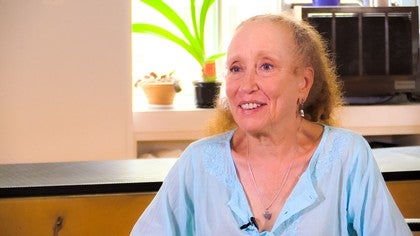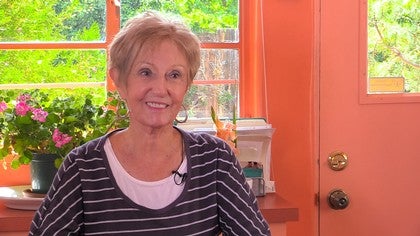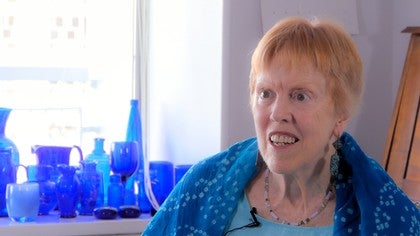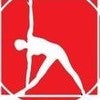Description
Judith also shares fascinating stories about working with Kathy Grant and Romana Kryzanowska in Carola's studio and how different each teacher was. She recalls an interesting conversation with Kathy Grant where Kathy explains how Carola is more like Clara Pilates than Joseph Pilates. It is so wonderful to hear more about Carola to get a sense of what it was like in her studio. We hope you enjoy it!
About This Video
Transcript
Read Full Transcript
My name is Judith Hellman coven. Neufeld coven was the first husband and Neufeld is the second husband. And um, where I was born in New York City, I always loved dancing. Um, of course I saw the red shoes, which I think started everybody dancing in those days. Um, but I, I always love music and the combination. And when I was 12, I s I hadn't danced. I started late, which 12 is late. And, um, my local teacher in Mount Vernon, New York, where we had moved when I was six, my local teacher kept talking about George Balanchine in the School of American ballet. So when I was 13 and a half, I went to the School of American ballet for their summer course.
And um, I stayed. That was, I loved it. It was my first love. That's all I can say. And I was there and progressing nicely, but nothing special cause I had really started too late. Um, sometimes, you know, if you start that late, your body doesn't do, it's, I was already mature when I went to the School of American ballet. I had my period, sorry. And, um, I was fully grown and so everything was the way it was going to be pretty much. And so I wasn't anything special. And uh, the next leads into how I met or got to know about Corolla. So when I was 16, I developed a stress fracture in my, uh, in one of my metatarsal bones and the stress fracture was, I was not allowed.
Went to see Dr. Jordan at Lenox Hill Hospital and I was told I could not dance for six weeks. Well at that age and with my mentality, that was the most dreadful thing I could have heard. So I was at the School of American ballet watching classes and being terribly unhappy when Suki Shura, who was with the New York City ballet at the time said you should go to Corolla. Trior I had never heard anything about that. I went, I made, I spoke to my parents and I went and I met Corolla and that was the beginning of something very, very, very special for me. Um, we, because of my foot injury, we did not start the most orthodox way cause I was not allowed to use my, to put any pressure on, on my feet. So, um, but I remember her first, her first introductory speech, which she gave and when she gave it, things started to click. So amazingly for me, um, because I had been doing my ton dues and my plea A's and I didn't know why I was moving my, but I didn't know what precipitated movement and as Corolla talked and then she got me down on the apparatus. Um, and as she spoke and touched me, um, I began to feel for the first time the animal way of moving, the instinctive way of moving from your center, from your core, that everything moves outward from the center as opposed to, you know, if you want to get your leg up here, you hold your foot up here.
It was all in. Instead, I got a sense of how it was all pushed out from the center and with the breath with the breathing and how natural it was. So I worked with Corolla for those. Uh, must've been about five weeks by the time I got to her. And, um, when I went back to the School of American ballet, I was at the bar and Alegra Kent was next to me at the bar and after the, after a few of the basic bar exercises, she looked at me and she said, what has happened to you? Where have you been? You look like a dancer now. Now I thought I was going to be totally out of shape and instead, um, I had, I never felt better in my ballet classes. Um, and it was then actually that, um, everybody started paying attention, real attention to me.
And then I got put into what balance sheet designated as his special class, which was for those he was grooming specifically for the company. And, um, things took off. Uh, it was amazing. And that was after only five weeks. I took to it like a fish to water. I, I just loved everything about the movement's about the way Corolla taught it. And, um, it felt so natural to me that when I joined the national ballet in Washington DC and was away from it for awhile.
I mean I would do mat exercises, but, uh, it wasn't enough for me at that point. And I felt I, I would run to New York every opportunity I could just to be back in Corolla studio doing the exercises. And at that time when I was going, I think she was charging $5 a session, which for me, my father was very strict. I mean, he was a very good man, but he constantly complained about the money I needed to do this. And I was going three times a week. And so I asked Corolla if I could have the three sessions for the price of two.
She said yes, I joined the national ballet of Washington in 1961. And, um, I was there 1962 cause I was there for five years. And then I decided that I wanted to have a family and that I was not capable of the kind of, um, but I was very dedicated to dance, but I also was very dedicated to having a family and I was not capable of splitting myself that way. So I stopped dancing. But I knew that I wanted to, uh, teach [inaudible] that I wanted to go to Corolla. And I, as soon as I stopped have seeing, I went to her and I asked her if I could train as an assistant.
And she was delighted. I mean, she was actually, she was very sad that I had stopped dancing. But, uh, she was delighted. And again, I felt like it was so natural for me to do it. I'm a very physical person, very, very physical. And, um, for me, I did and had no problem touching other bodies so that, that part of it, I didn't have to overcome any, um, nervousness or, or uncomfortable feelings about that. And, um, Corolla started teaching me. It was very hands on. I mean, she would have me teach people, you know, like the basic footwork on the apparatus and, um, not certain things took longer. Um, working with somebody when they're up on their shoulders and doing a jackknife and pressing them down. That took longer. But, um, I kept a notebook. I had the breathing for every exercise. Exactly. I mean, I had her words, um, her, you know, roll down one vertebra at a time and I can tell you that the Virta everybody else would, they'd look at you like you were very effected when you said that.
But there was one woman who went to Corolla, Corolla used to say vertebrae, one vertebrae at a time. And this very wealthy, uh, elderly woman corrected her and said, it's not vertebrae. If it's a, say if it's the singular, it's vertebra. And from then on we had to say it that way. So I found it very comfortable working with people.
Um, Corolla when I was pregnant with my first child Karole I, I got a very severe, stiff neck and Corolla, um, said, well, she recommended, uh, uh, uh, Miss, uh, that other people, specifically dancers, a lot of dancers went too. And I was like four months pregnant. Uh, he was there. He, he didn't know what to do with me because I was pregnant. He didn't want to press I guess, and he did nothing for me. It was expensive, but he did nothing. I mean, he, he kind of diddled around on my back and it didn't do anything. And so I went to, and I said, look, I can lie on my stomach.
You can press, there's no problem. And she said, well, lie down young lady. And she gave me a massage that she had an [inaudible] license. Um, and she came me a massage that, no, I mean, it taught me the very basics of the anatomy of the muscles. I never forgot it when I got up from the table, the, I could not move my head when I lay down. And when I got up, I, it was gone.
It was totally gone. And I learned so much from that, that when I did open my own studio, that was my specialty, just from that one time that she touched me, it was so, it gave me so much information, um, about an I'm not educated about, so I don't know the names of all the muscles, but I do know where they are by feel and touch and what they do. And she was brilliant that way. So, um, anyway, I trained as an assistant and I was working for her. The Corolla had a, a, I stopped working for her for a while because it bothered me. She never yelled at me. She, she adored me and I was kind of a little f her favorite little girl.
Um, but, um, she sometimes had a habit of not treating her, her clients or her other assistants very well. And that bothered me. And so I, I left her saying, I, I'm really having a hard time dealing with how you treat other people. Then her husband, Edgar passed away and I went to the funeral and I, we hugged and kissed and I said, I'd like to come back. And, um, then I was there for, so I was, I worked with her as a student for about five years and I worked as a, as an assistant for another five. After I stopped dancing. When I first went as a 16 year old, I was, um, I usually went at eight o'clock in the morning.
So I only really knew what the people that were there, uh, in the morning sessions. And, uh, one, the one person I that I remember was Kathy Grant, who was Kathy Sanford at the time. Um, and she was a wonderful teacher. Wonderful Corolla, had [inaudible] uh, dare I say it. Um, Corolla made her wear a nurse's uniform. Kathy was a dancer. She had danced with Arthur Mitchell. Uh, she was a modern dancer, but, um, they got together and did something on television. She was a very good dancer and she had a beautiful, lovely body and Corolla had her put on a white nurse's uniform.
And I, I didn't know why this was when I first got there. Um,
Um, but you know, funny things happen like that. Um, anyway, Corolla was the person I worked with the most. She liked working with me a lot. Um, but Kathy taught me a great deal too, and the combination of the two of them was, was superb. A lot of the New York City ballet went to her and they had to, they did these sessions before they took class for the most part. Um, and this was wonderful and exciting for me because I was working with these people that I aspire to be like. And, um, then we would all share a cab up to the New York City, uh, up to the school of American ballet for class. But, um, Corolla when she worked, I don't know, I understood everything she was trying to tell me and more, um, it just, it felt so natural.
I my, I'm not so sure that I am the best person to assess what the studio was like. So because I was 16 and very into myself, so mostly it was deep concentration on my own body and, um, Corolla loved that aspect of my focus on, on my body. And, um, I didn't ask many questions. I didn't feel I needed to ask questions. Everything she said made sense to me. So, uh, and, and then she asked me to model for some of her, uh, for some articles that were being done about her. And, um, I did, um, that was just part of the fun, but I, you know, nobody was ever paid for that. Um, it was just, uh, the way you did it. I, when I first went to Corolla, I was not aware of the polarity studio until she mentioned them.
Basically, she's the one who, who gave me the awareness that this, that she had gotten what she knew f elsewhere. And she always talked well, um, wonderfully well about Joe [inaudible] and I knew there was a studio out there. I never went to the [inaudible] studio. I was strictly a Corolla person. I got a sense that things were taught a little bit differently at Carola's because sometimes, um, Ramana would come and assist Corolla when gorilla one of Corolla's others' distance was not there. And she taught things differently than Corolla did. Um, it was Corolla taught very therapeutically.
It was not once. I mean she did have me, you know, climbing all over the place and hanging and doing all kinds of things. But the basics were very therapy, therapeutically taught the breathing. The, um, I got the feeling that, well, at least from the way that Ramana taught, um, that it was a little more by the numbers. It was, you know, you do 10 of this and 10 of that and 10 more gym like, um, and that wasn't what I needed was different. And I can't tell you that when, when I first, well, no, I wasn't there, but I heard talk about this when ta Tana Kyla Claire came down with polio when the New York City ballet was in Denmark that Balanchine brought her to Corolla balancing, worked at the [inaudible] studio. But Corolla was known for having a different kind of touch and he brought a broad 10 killer cleric there for that specifically. I mean, there was nothing Corolla could do. Uh, but at the time he was still hoping and he brought her because she was, um, specifically known for being able to help.
For instance, Suki Shura had had polio also when she was younger and it affected one of her arms and Corolla worked with her and it really, really made a difference. Really helped. I mean, she knew what muscles could take over for the muscles that didn't, weren't getting the nerve feed. I had a long conversation with Kathy grant. It was Kathy who actually kind of pointed out to me that the way Corolla taught was more modeled after Clara, who taught with Polato [inaudible] alongside him. But she, she taught more, um, Sutter. It was more subtly, um, polities was he joke a lot. He's, from what I understand, and I have never met him, but I've heard loads of stories and he was not subtle. And by subtle I don't mean that it was hard to understand.
I mean he was much more like do it and Corolla was not that way. It may have seemed that way to some people, but the if side by side, if you put the two side by side, and Kathy pointed out that Corolla talked much more like Clara, that Corolla because she had had a back injury and a back problem was nurtured by Clara [inaudible] and taught a lot by Clara, who I think has gotten no recognition at all. But she must have been quite wonderful. I did meet Clara once after Joe died, but she was a very old lady at the time. And, um, I was still young enough to not connect quite when I left Karola the second time that I left her because she could not pay me or would not pay me enough to do, enabled me to have somebody in for the children during the hours that I was at the studio. Um,
And, um, she's, she went back on what she had told me, which I was very headstrong, probably similar to the way she was. And I, um, said a nasty word on the telephone to her and she was very straight laced German, um, always really well dressed. And, um, other than her temper tantrums, she was very well mannered. And this was something that no proper young lady should have said. Nobody, uh, she, she could not forgive me for saying that word. So she told me to come and pick up my stuff, my coach, my little bundle bundle of Leotard and tights and shoes that I had there.
And, um, so I went and I went to pick them up and she wouldn't even talk to me. And so I went downstairs and it was in the lobby and I was crying. And, um, jock Dunn was, who was with the New York City Ballet, was came down into the lobby too. And he said to me, Judy, if you, you should open your own place if you open it. Merrill Ashley, who was also going to Corolla at the time, um, and who was just in the quarter ballet at the city in New York City ballet, Merrill, Ashley, and I will be your first customers. So gave me an idea and I went home and I spoke to my husband at the time and he said, do it. We can give up our bedroom. We had this beautiful, beautiful master bedroom, um, overlooking a backyard and trees.
And it was a wonderful place to have a studio and it had its own bathroom and old closet space and everything. So it was, it was perfect. So I spent, um, about three months getting it together. And, uh, in the meantime, I got a call from a Dr Leibler who was at Lenox Hill hospital and who Corolla sent a lot of his dancers to, but he sent, he said, would you please, there's a young dancer who has really bad knees and, um, she was very hyper extended and, um, she was having major problems with her knees. She was 18. She said, would you please take her? She needs to be taken right away. She can't dance right now. And she's very talented and I don't want to send her to Karola.
He was a little afraid. She was a young black woman. And again, he was a little afraid that she, that gorilla wouldn't treat her right. I don't know. I don't know if that's, I, I didn't see that in Corolla. I didn't see her treating people with double standards. Um, but maybe he felt that this young lady who was named Diane Harvey, um, needed special nice treatment. I was a generation younger, 30 years younger, but partly we came from the same background, from that Eastern European Jewish background.
And so we connected like, um, family and anybody who she connected with that way was very w she treated differently in a way. I mean, either she connected like family or some of the dancers like Frank Muncie on Francisco monsoon who was her very special. Um, he was a dancer also with a New York City ballet, but he helped her out in the studio and she connected with him beautifully. But Arthur Mitchell also went there and, um, she connected him wonderfully well. So I'm not sure that she was prejudice. I just think that Liebler was trying, Dr Leibler was trying to be a little careful with Diane Harvey.
Diane, uh, became my first client before I was fully set up to start taking other people in because she needed it right then. And since it was her knees, while I was working on a lot of aspects of the studio and, and some of the equipment, I started her with mat work because it was very important that she, uh, at that point, not put pressure against her knees, but worked to, um, work to learn how to work from her buttock muscles and her quadricep muscles, um, in a way that would protect her needs when she got onto the apparatus. So, um, she came to me and I worked, uh, I started working, Oh, I opened my studio officially in May of 1974 and I took her in April. And then once I started, I got, um, the New York City ballet started coming to me, including Suki surer, who had recommended gorilla because I was working from a dancer, from a ballet dancers, um, point of view, not because I was better, but also they got more personal attention with me because I was the only one there. And I, it was very, very small.
The studio that I ran and I didn't want to do it for too many hours, but it turned out that I was working from eight to four every single day without a break for lunch because I had to accommodate the people that were coming. And, um, there was a point, I mean, I don't know how Corolla did it in the studio because she was there from eight until seven o'clock in the evening or six 30. And it's, I think it could make you pretty crazy not to go out. I mean, at four o'clock I was out, I was playing with my children, I was doing other things, but it's, it's very heavy duty service that you're doing for people and you always have to be on. And so that, it wasn't all that different from performing. Um, anyway, it turned out really well for me. I supported myself, um, and went through a divorce.
I was able to support myself and my two children. Um, and uh, here I am at 70 years old. I just retired two years ago and I miss it. I miss it, uh, for a lot of reasons. But it was the right time for me to stop. I mean, I missed it because I loved, I love working with people. I love working with them. Um, emotionally and physically.
And there's a lot of the emotional that comes into this work. People come to you with their problems and you have to, it affects their body. It effects everything. So you have to work with that. Um, one of the things I did, I think that Corolla did too, was not talk too much about anatomy and um, every little tiny part of the body but to the body became like a blossom, like a flower opening, opening up and um, everything you did connected to those feelings. And I think, um, while she had a tremendous amount of knowledge, she had studied anatomy, she had, she was a licensed, licensed misuse. But, um, she didn't try to teach you as if if you remembered certain things, you would then be able to do them. You had to feel them. And, um, one of the problems with some people that I think drove her crazy was that no matter how many times they did something, they didn't, it didn't, they didn't connect with it.
It wasn't her fault. It wasn't, I, as a matter of fact, I mean, different people move differently. And there was one young dancer from also from city ballet who had legs that were so much longer than they should have been in a tiny little body. Uh, there was, it was very hard for her to control and Corolia was to get very upset with her because, um, she just, it didn't connect her body. Um, wasn't, it didn't make sense of the exercises. And that can happen. I mean, not everybody makes perfect sense. Although I must say towards the end, I looked over, looked over all my clients and they all seem to get it. So maybe I had, I had more patients that, uh, than Corolla. Maybe not in my personal life, but in my professional life I had a lot of patients.
I had somebody who came to me and had been told by doctors that she had been in an accident. She had arthritis in her, in, in her neck, and she was told never to stand on her shoulders and she absolutely refused to stand on her shelters. So I worked with her for about a year, gradually, gradually going higher and higher and higher up. But so gradually that, uh, by the time we got there, uh, she didn't know she was doing it. And now she is, she's amazing. And the thing is, is that what it did was, um, actually strengthen that area that the doctor said she shouldn't, um, put weight on, but putting weight on it. She had a bone density test and the bones got stronger. Um, they, she had had a lot of bone loss in that area.
And afterwards, once she started being able to do that, uh, her bones picked up and got stronger and they were no longer at risk. So that's, but it took so long. Corolla would never have had the patience. She would've just said, look, if you don't want to do it, get out. Um, I kind of felt like this is the way this lady has to work. Let's see, I was 30 when I left her for good. And the reason I did was I needed more money. I could not support having somebody taking care of my two at that point.
Four on the amount of money that Corolla was paying me. And, um, we had a little spat about it. Um, I am sorry that I missed 25 years with her. I finally called, I called her cause I met a friend of hers, Margaret on the street and Margaret said, you know, Corolla loves you very much and she won't call any, she has had a couple of assistants named Judy and she won't call them Judy. She insists on calling them Judith because you're the only Judy and I, I mean I always loved her. I never spoke, you know, a lot of people leave her and they angry at her and they, they didn't like the way she was. Um, I understood the way she was. She was a very, a highly emotional human being. And, um, she was also German and that was part of the, I would imagine the family she grew up in and, um, what she was used to. Um, I was used to it too because my father was kind of like that. So I called her and I said, gorilla, you know, I love you very much and I always have over these 25 years that I haven't seen you, that I've been teaching. And she said, can you come over and visit? And I said yes. And when I got there, she was all dressed up and she had ice cream for me and I always, she used to try to feed me all the time and I used to refuse, I didn't want to eat all the time and she was kind of always pushing food at me.
And then she had this big dish of ice cream already for me and I ate it. And I told her how much I loved her. And then it was only a couple of weeks after that that she went into the hospital and I'd spoke to her in the hospital. Um, I think she knew she had a heart condition. So anyway, that's, that's that. But we did, uh, and she told me that she thought of me as a daughter at that when I met her in her apartment that she, she said, I that, you know, she's always thought of me that way. And now that I'm older, I know how fast five years passes.
It seems like nothing when I left Corolla. Um, and it was with not great feelings. I didn't know where I would get any equipment except for the Palati studio. So for the first time in my life, I went to the bollocks studio and I had known Romana from when she came to work at, um, gorillas. And also because she was the mother of Paul Mahalia, who was with the New York City ballet and therefore the mother-in-law of Suzanne Fattal feral. And so I, I knew Ramana through those different ways and I went to her and I told her that I wanted, that I'd had an argument with gorilla and I wanted to open my own studio. She seemed, she seemed actually a little pleased about that.
I don't know why, but she had one old apparatus, one of the original. Now I know that, um, was that the piece of equipment that Wa the, that Pilati is called the reformer. A Corolla called it the apparatus, which is, I know, I don't care what you call it, it does the same thing. Um, but, uh, she had one of the original ones and it was very old, um, painted silver. This is interesting because when he first did these, um, he wanted to make these look modern and since they were made out of wood, the frames were made out of wood in those days. The thing to do is to paint it over with silver paint so that it looks like metal. So he, there was all this gorgeous wood that had been painted over. It had lions par legs, and, uh, it was much closer to the type of equipment that Corolla had then anything that I saw at the [inaudible] studio, which by that time they were making an aluminum, um, a lot, all of the equipment and I didn't like it.
It was, the equipment itself was too lightweight. It was, um, not substantial. Um, anyway, Ramana said she would sell me this piece of equipment, which was still at their old studio. Um, it was so I had to go from the new studio to old place. It was still kind of being stored there. And, um, she sold it to me for $500. It was falling apart. I had a, I mean, you know, you could do this with it. It, the joints were all coming apart, but my husband at the time was a really good carpenter. And so that was not an issue.
And she allowed him to come over and make measurements of the, what they call the Cadillac or the bed. And so, um, and then he put that together with, uh, he went to a hardware supply store and got plumbing pipes and stuff. It was all done with, with pipes. And, um, and I went traveling all over. I went to Connecticut to Newcomb springs to get springs. I went someplace way out in long island to get webbing to go on the, um, springs. And, um, and then I had to locate the d-rings. Uh, everything is, and I was doing that on my own. Uh, it just, all, it all came together and I was very, very busy working with a lot of dancers and then a few and a few people who had been at Carola's called me.
I never ever solicited any of them. But, uh, I kept getting calls, phone calls. I was full up for a long time and then I started limiting my hours because I, to work with the ballet dancers, you have to be on call all day long cause they never know their schedule from one day to the next until it gets posted like the evening, evening before. So they never know when they could come and I didn't want to be on calls and I was limiting my hours. I where I decided I wanted to work in the early morning and sometime in the afternoon and have some time in the middle of the day to do some other things. My practice got smaller, if you could call it a practice, whatever it was. Um, it got smaller because I did not really want to be on call all the time. My dedication to the work was not, I was never in it to make a lot of money, and I certainly didn't make a lot of money.
That was not what I was interested in. I never actually wanted to, I wanted to work for Corolla. Never actually wanted to have a studio of my own. I wasn't so interested in, I didn't want a name. When I went, when I went to get the [inaudible] equipment, Romana made me sign something saying that, um, I would not open a studio within 20 blocks, a 20 block radius of the Palati studio. And I said, no problem. Didn't I lived up in the 90s in this.
So there was no problem. Um, and she also told me that I could not say that I was teaching [inaudible]. So I said, no problem because I wasn't teaching [inaudible] I was teaching Corolla.
Pilates Legacy Project: Discussions
Comments
You need to be a subscriber to post a comment.
Please Log In or Create an Account to start your free trial.

















